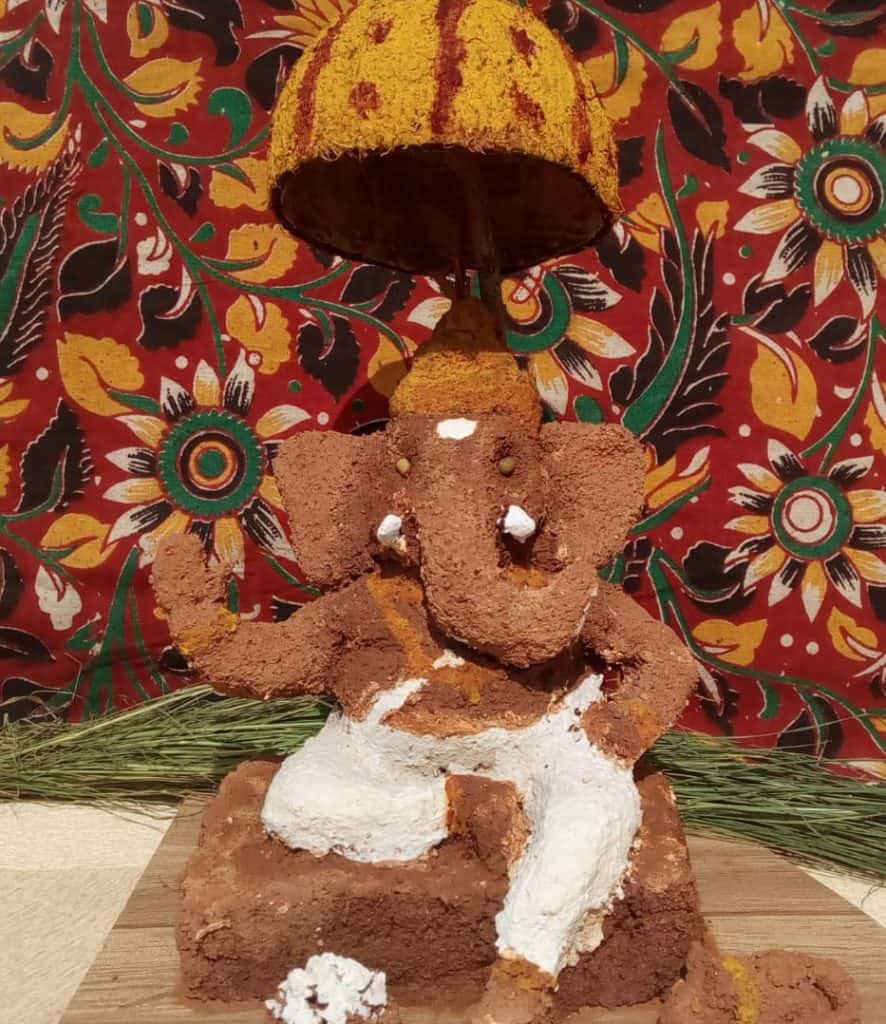With Ganesh Chaturthi just around the corner, beautifully crafted Ganesh idols have begun to brighten up the streets of Chennai. Even though the colourful, plaster of Paris idols are visibly high in number, clay ones are in the market too. According to Kumudha R, a vendor at Mylapore market, the demand for clay idols has been increasing, thanks to the awareness generated on eco-friendly or ‘green’ festivals. “People have become more aware of the damage caused by Plaster of Paris idols. So they opt for mud ones,” says Kumudha.
The demand is evident from the increasing price of clay which has spiked up to Rs 2000 a tonne this year from Rs 1000 a year ago. “I used to sell a medium-sized idol for Rs 50 last year. Only if I increase the price to Rs 60 this year shall I be able to make any profit. The idol needs soil of good density with less water content to ensure its stability and firmness. Soil has to be sourced from the outskirts — Cowl Bazaar, Padappai and Manimangalam. It is also transported from Kancheepuram and Tiruvallur districts,” said Dinesh B, an artisan who makes mud Ganesha idols.
But can mud Ganeshas purchased from the market really make the festival green? Attention eco-friendly warriors. Mud idols may be less harmful but it would be illusionary to call them ‘eco-friendly.’ The clay used in making the idol belongs to the water bodies from the neighbouring districts of Tamil Nadu. And we end up displacing the lake/river bed clay in the ocean at the time of immersion thereby disturbing the marine ecosystem.
“Mud gets into the marine ecosystem when water from a river flows into an ocean. It is the natural way. But when we immerse mud Ganeshas — along with all the paraphernalia of flowers, paints and decorations — in the ocean, it only causes pollution,” said Dr V Selvam, former Executive Director and Lead – Coastal Systems Research at the M S Swaminathan Research Foundation.
But what’s the alternative, then? We spoke to zero waste practitioners and environmentalists to get pointers on celebrating Ganesh Chaturthi in the greenest way possible.
How to make your own green Ganesha
Ganesh Chaturthi is usually celebrated before the commencement of monsoons in Chennai. The mud in our water bodies serves to strengthen the bunds of the lakes and rivers. So think of the outcome when you dig up mud from a lake in Vellore for idol making and then immerse that idol in the waters along the Marina. That’s exactly what happens when you purchase a mud idol from the market. It is thus a far greener option to make your own idol.
Nithya T, a zero-waste practitioner who is organising a workshop on the same shares her inputs: “With red soil (two to three shovels) from your garden and cow dung (two to three spoons) as a binding agent, we can make beautiful idols,” Nithya says. Sieve out the stones from the soil and ensure there is no organic matter in it.
If garden soil is not available, visit the nearest park and borrow some soil to make the idol. Put the idol in a pot at the same park and pour water. You can even plant a sapling there to symbolise your effort.
Or if making an idol sounds intimidating, you could simply worship the picture.

Nithya made this Ganesha with garden soil last year. Do look at the coconut shell that became an umbrella.
“It is difficult to start with, as you miss out on the joys of purchasing the idol. But, a picture means no plaster of Paris, no soil displacement, no paints and no thermocol,” says Janani Jagan, a volunteer from Namma Ooru Foundation. Janani has bid adieu to idol Ganeshas two years ago and has been using a picture since then.
|
Green decorations
You just need to brush your creative skills and believe in low waste festivals. Using green gram or beans to make the eyes of Ganesha is one option. Umbrellas can be made with newspapers, wedding cards or quilling paper.
| Decor items | Eco-friendly alternatives |
| Serial lights | Mud diyas |
| Plastic umbrella | Do it Yourself ones with papers, wedding cards and quilling paper |
| Colours for Rangoli | Turmeric and Kungumam |
| Plastic cups to offer prasadam | Stainless steel cups |
Celebrations and prasadam
Apartments and resident welfare associations celebrate the festival with great pomp and splendour. When you serve the food for guests, make it a point to use stainless steel. You can rent them from
- Rent-A-Cutlery – 9731211364
- Namma Cutlery Bank – 8754483679
You can check out a few other places at this link.
Immersion
Here are the broad guidelines issued by the Tamil Nadu Pollution Control Board (TNPCB) for the citizens to follow during the immersion of idols:
- Immerse idols only in the places notified for each district by the District Administration in order to protect our water bodies. The city police will soon be releasing the list of places for immersion.
- Idols made of raw clay (not baked) and other eco-friendly materials such as Kizhangu flour or sago waste and without any chemicals shall alone be permitted for safe immersion in water bodies.
- Idols painted with water-soluble and non–toxic natural dyes only will be allowed for immersion in water bodies. Do not use toxic or non-biodegradable paints and/or chemicals for painting the idols.
We could, of course, go a step further by composting the flowers and immersing the idols in our garden or at the nearest park. After all, Ganesh Chaturthi is about worshipping the Lord. Let’s not ravage the Earth and abuse our water bodies in the name of a celebration.